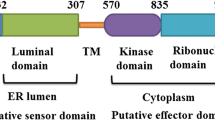Abstract
The cDNA encoding brain protein 44-like (Brp44l) was identified from the brain and spinal cord cDNA library of Gekko japonicus. It contains a 324 bp open reading frame corresponding to a deduced protein of 107 amino acids. The molecular weight of the BRP44L protein is 12.2664 kDa and its theoretical pI is 9.67. At amino acid level, the BRP44L from gecko shares 85–89% similarity with those from other species. Northern blotting showed that Brp44l was ubiquitously expressed in the major organs of Gekko japonicus including brain, spinal cord, heart, lung, liver, and kidney, suggesting a fundamental biological role of this gene. In situ hybridization (ISH) revealed that positive hybridization signals were present in gray matter of spinal cord. The change of Brp44l expression in spinal cord after tail amputation was examined by reverse transcription polymerase chain reaction (RT-PCR). The expression level of this gene increased in the spinal cord after tail amputation, and reached the highest value at 1 week after tail amputation, which indicated that the expression level of Brp44l might be associated with the process of spinal cord injury and regeneration.






Similar content being viewed by others
References
Ferretti P, Zhang F, O’Neill P (2003) Changes in spinal cord regeneration ability through phylogenesis and development: lessons to be learnt. Dev Dyn 226:245–256
Chernoff EA, Stocum DL, Nye HL, Cameron JA (2003) Urodele spinal cord regeneration and related processes. Dev Dyn 226:295–307
Echeverri K, Tanaka EM (2002) Ectoderm to mesoderm lineage switching during axolotl tail regeneration. Science 298:1993–1996
Egar M, Simpson SB, Singer M (1970) The growth and differentiation of the regeneration spinal cord of the lizard, Anolis carolinensis. J Morphol 131:131–152
Simpson SB (1968) Morphology of the regeneration spinal cord in the lizard, Anolis Carolinensis. J Comp Neurol 134:193–210
Du S, Cheng L, Liu D (2002) Advances of systematic research of the genus gekko (sauria: gekko nidae). Sichuan J Zool 21:200–204
Cristino L, Pica A, Della Corte F, Bentivoglio M (2000) Plastic changes and nitric oxide synthase induction in neurons which innervated the regenerated tail of the lizard Gekko gecko II. The response of dorsal root ganglion cells to tail amputation and regeneration. Brain Res 871:83–93
Alibardi L, Miolo V (1990) Fine observation on nerves colonizing the regenerating tail of the lizard podarcis sicula. Histol Histopathol 5:387–396
Alibardi L (1995) Muscle differentiation and morphogenesis in the regenerating tail of lizard. J Anat 186:143–151
Duffy MT, Liebich DR, Garner LK, Hawrych A, Simpson SB, Davis BM (1992) Axonal sprouting and frank regeneration in the lizard tail spinal cord: correlation between changes in synaptic circuitry and axonal growth. J Comp Neurol 316:363–374
Liu Y, Ding F, Liu M, Jiang M, Yang H, Feng X, Gu X (2006) EST-based identification of genes expressed in brain and spinal cord of Gekko japonicus, a species demonstrating intrinsic capacity of spinal cord regeneration. J Mol Neurosci 29:21–28
Zdenek T, Jiri F (2001) Synteny of orthologous genes conserved in mammals, snake, fly, nematode, and fission yeast. Mamm Genome 12:227–231
Da Cruz S, Xenarios I, Langridge J, Vilbois F, Parone PA, Martinou JC (2003) Proteomic analysis of the mouse liver mitochondrial inner membrane. J Biol Chem 278:41566–41571
Rehm BH (2001) Bioinformatic tools for DNA/protein sequence analysis, functional assignment of genes and protein classification. Appl Micro-biol Biotechnol 57:579–592
Altschul SF, Madden TL, Schaffer AA, Zhang J, Zhang Z, Miller W, Lipman DJ (1997) Gapped BLAST and PSI-BLAST: a new generation of protein database search programs. Nucleic Acids Res 25:3389–3402
Burland TG (2000) DNASTAR’s lasergene sequence analysis software. Methods Mol Biol 132:71–91
Felsenstein J (1997) PHYLIP (phylogeny inference package). Department of Genetics, University of Washington, Seattle
Zhenkun C, Guang D (1990) Dissection of the skeletal system of gecko. J Yunnan Agricult Univ 5:1–6
Tseng AS, Adams DS, Qiu D, Koustubhan P, Levin M (2007) Apoptosis is required during early stages of tail regeneration in Xenopus laevis. Dev Biol 301:62–69
Acknowledgements
This research was supported by a grant from the National Basic Research Program (973 Program) of Ministry of Science and Technology of China (2003CB515306), a grant from the National Natural Science Foundation of China (30600172), and a grant from Basic Research Program of Jiangsu Education Department (05KJA31010).
Author information
Authors and Affiliations
Corresponding author
Rights and permissions
About this article
Cite this article
Jiang, M., Gu, X., Feng, X. et al. The molecular characterization of the brain protein 44-like (Brp44l) gene of Gekko japonicus and its expression changes in spinal cord after tail amputation. Mol Biol Rep 36, 215–220 (2009). https://doi.org/10.1007/s11033-007-9169-0
Received:
Accepted:
Published:
Issue Date:
DOI: https://doi.org/10.1007/s11033-007-9169-0




